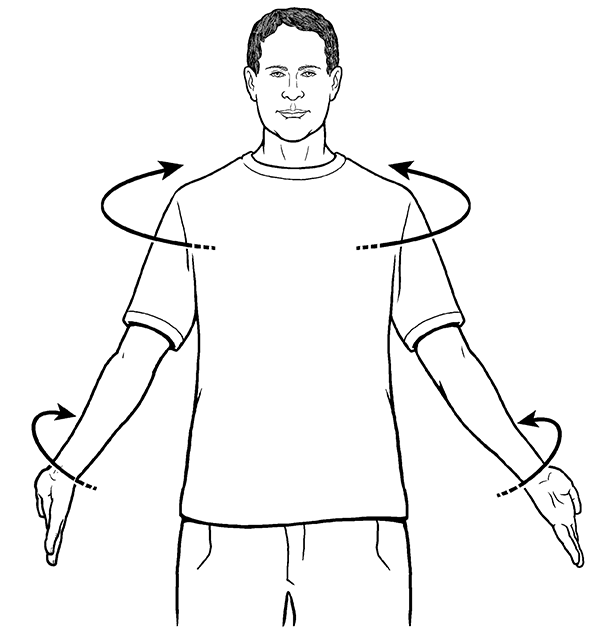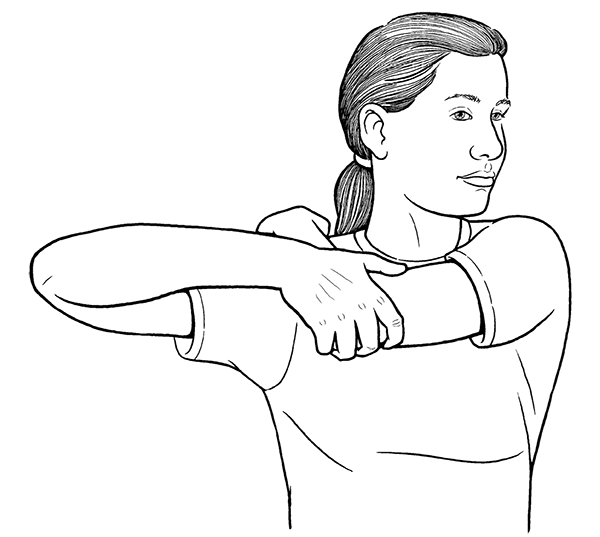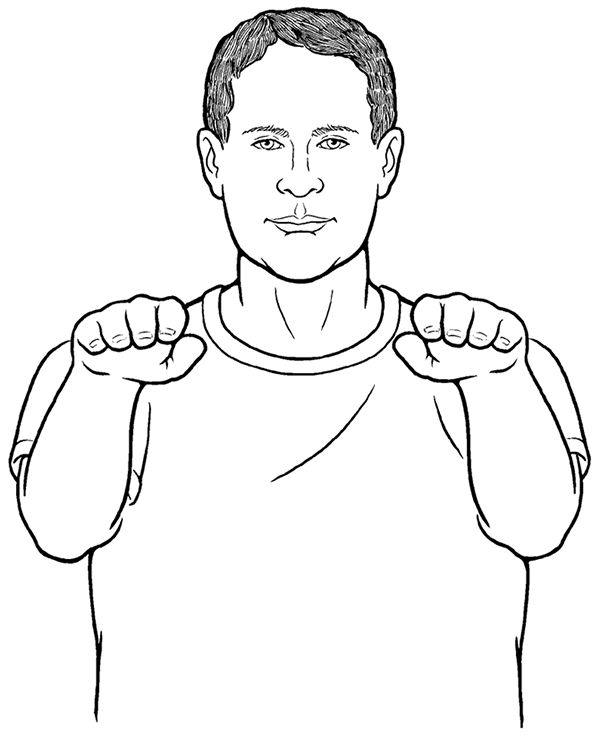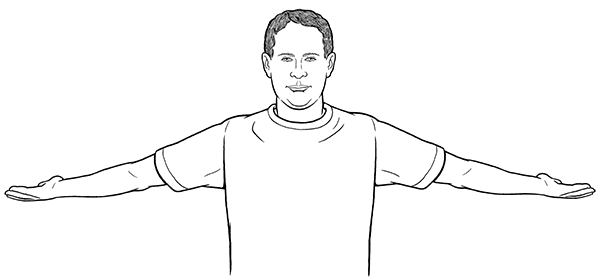Read Chinese Healing Exercises Online
Authors: Steven Cardoza
Tags: #Taiji, #Qi Gong, #Daoist yoga, #Chinese Healing, #Health, #medicine, #remedy, #energy
Chinese Healing Exercises (14 page)
 Figure 5.3B (Shoulder Blade Protraction
Figure 5.3B (Shoulder Blade Protraction
and Retraction with Arm Rotation)
4. Hand Over Shoulder Stretch
Purpose
Physical:
Increases the stretch and opening of the back of the shoulders.
Energetic:
The benefits are similar to those of the Shoulder Rolls. Although this exercise is very different, it addresses the same region of the body in a way that opens and stimulates the same points, in a slightly stronger way.
Techniques used
Passive stretch, guided breathing.
Method
Sitting or standing, place your left hand on your right shoulder, with your left elbow pointing straight in front of you. With your right hand, reach over your left arm and grasp it just above your left elbow. Turn your head to the left, as far as is comfortable, while you pull your left arm to the right
(
Fig 5.4
on next page
).
If your left shoulder is able to open and stretch, your left hand will slide behind your right shoulder, toward your right shoulder blade.
When you've reached the end of your stretch, hold it, and take a few slow, deep breaths. Breathe into your left shoulder, and on each exhalation, try to release more tension from that shoulder. Your stretch may increase. Hold this stretch for about thirty seconds to begin with. As you end the stretch, allow your head to face forward once more. Then repeat this stretch for your right shoulder. Gradually increase the length of the stretch to two minutes over the course of a few weeks or longer.
 Figure 5.4 (Hand Over Shoulder Stretch)
Figure 5.4 (Hand Over Shoulder Stretch)
5. Whole Arm Tap and Pat
Purpose
Physical:
Softens and relaxes all the muscles in the arm; increases blood flow through the arm; prepares the arm for the following exercises.
Energetic:
Strongly clears energetic blockages throughout the arm; stimulates qi flow through all the Arm meridians (Heart, Lungs, Pericardium, Small Intestine, Large Intestine, and Sanjiao).
Techniques Used
Paidagong: The gentle impact caused by tapping and patting induces a penetrating wave of energy through the body. When that wave encounters a pocket of stagnation, it can gradually break it up when applied over time, like a constant drip of water can wear down a boulder. Often it will happen more quickly than you might imagine. As that stagnation breaks apart, any associated health problem will resolve.
Method
Sitting or standing, hold your right arm loosely extended front of you. Curl the fingers of your left hand into a soft fist, not tightly clenched, with a little sense of space at the center of the palm. With any part of your fist that is easiest for you (back, sides, or front), tap and pat down your right arm, starting where your shoulder meets your neck, and slowly work your way down to your wrist. Tap and pat down and up your arm a number of times. Make sure to include the front, back, and sides of your arm equally. Vary the rate, rhythm, and force of the impacts, so that your body won't be able to adapt to a repetitive pattern. While this is not crucial, it will enhance the benefit you get. Do not pat or tap strongly enough to hurt yourself. If you find any area of tenderness, you should stay on that area just a little longer than the others, since that indicates an area of stagnation that needs dispersing. Then repeat for your left arm.
6. “Breast Stroke” for the Shoulders
Purpose
Physical:
Strongly stretches and opens all regions of the shoulder; stretches and benefits the front of the chest; massages and pumps the region between the shoulder blades; pumps the inner (front) surface of the shoulder blades toward and away from the back of the ribcage. This massages the subscapularis muscles, often a hidden source of shoulder and upper back pain; increases blood circulation in the arms, all the way to the fingertips; mobilizes and lubricates the joints (shoulder blades, shoulders, elbows, wrists, hands, and may include the upper thoracic vertebrae, between the shoulder blades). The more you can access the region between your shoulder blades, the more you will also neurologically benefit your heart and lungs. The spinal nerves that innervate those organs exit your spinal cord just below the fifth and third thoracic vertebrae respectively.
Energetic:
Opens the shoulders energetically; activates the Shoulder's Nests; pumps and so activates the energy center (gate) between the front of the shoulder blades and back of the ribcage; strongly stimulates qi flow through all the arm meridians. In addition to energetically freeing up the whole arm, shoulder girdle, and chest, the net result is a strong benefit for both the Heart and Lungs.
Techniques used
Conventional and rotational stretch, active joint mobilization.
Tip:
For advanced practitioners already familiar with pulsingâa
neigong
practice, the teaching of which is outside of the scope of this bookâinclude pulsing open whenever stretching is stated, pulsing closed on the bends. Other pulsing variations are possible in this exercise, so feel free to experiment and see what works best for you.
Caution:
Unlike most other stretches in this book, there is a ballistic aspect to this stretch. That is, your arms move quickly to the end of their range of motion, and then there is a “bounce back” from that end point. Take care not to be too vigorous, especially if you have a current shoulder problem or if you easily dislocate your shoulder. Although injury is very unlikely in this exercise, it is possible.
Method
Stand and fully extend your arms in front of you at shoulder height, palms facing downward
(
Fig 5.5A
).
Pull your arms rearward, bending your elbows, retracting your shoulder blades toward your spine, and bending the palms of your hands a little so there is just a slight curve in your hands and fingers. To get your shoulder blades to fully retract, feel as though you are trying to touch your elbows together behind you
(
Fig 5.5B
).
(You won't really be able to do this!) Although your shoulder blades are close together, see if you can simultaneously feel them move rearward, stretching very slightly away from your ribcage. Do your best to keep your forearms relatively parallel, and keep your palms facing toward the ground. (This is the first ballistic point, at which your arms rebound forward.)
Then extend your arms forward again, stretching to their starting position
(
Fig 5.5C
).
Feel the stretch extend all the way to your fingertips, but do not overstretch any part of your arm or hand, so nothing feels hyperextended or locked. Feel your shoulder blades spread away from your spine and simultaneously move closer to your ribcage.


Figure 5.5A and 5.5B (“Breast Stroke” for the Shoulders)
 Figure 5.5C (“Breast Stroke” for the Shoulders)
Figure 5.5C (“Breast Stroke” for the Shoulders)
 Figure 5.5D (“Breast Stroke” for the Shoulders)
Figure 5.5D (“Breast Stroke” for the Shoulders)
Next, keeping your arms extended at the same height, move them out to your sides. While moving them to your sides, simultaneously rotate them, so that when your arms are fully out to your sides, your palms are facing upward, or possibly slightly to the rear of straight up
(
Fig 5.5D
).
This creates a rotational stretch through your entire arm, adding another vector through which qi can be stimulated, as well as providing the fullest wringing type of stretch for your muscles. Try to make sure you are getting that rotation to come all the way from your shoulders, and not just your wrists or elbows. In this position, your entire arm should feel its greatest stretch, all the way through to the tips of your fingers, more so than when they are extended straight in front of you. Your shoulder blades are once again fully retracted toward your spine, and are slightly stretched rearward away from your ribcage. (This is the second ballistic point, at which your arms rebound forward.)
